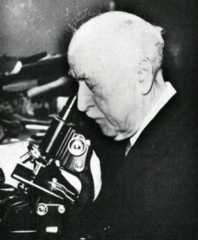Alexander William Evans
Alexander William Evans (May 17, 1868 – December 6, 1959) was a botanist, bryologist, and mycologist that specialized in the flora of Connecticut. The standard author abbreviation A.Evans is used to indicate this person as the author when citing a botanical name.[1]
Alexander William Evans | |
|---|---|
 Alexander W. Evans, photographed by Ivan Mackenzie Lamb | |
| Born | May 17, 1868 |
| Died | December 6, 1959 (aged 91) |
| Nationality | American |
| Alma mater | Yale University |
| Scientific career | |
| Fields | Botany |
| Institutions | Yale University |
| Doctoral students | George Elwood Nichols Margaret Hannah Fulford |
| Author abbrev. (botany) | A.Evans |
Early life
Born in Buffalo, New York on May 17, 1868, Evan's family moved to New Haven, Connecticut after the death of his father. After graduation from Hillhouse High School, Evans received his Ph.B. from the Sheffield Scientific School at Yale University in 1890. An excellent student, Evans was among the top of his class. Two years later, Evans earned his M.D. from the Yale School of Medicine. After a two-year internship at the Yale-New Haven Hospital, he went to the University of Berlin to briefly study botany under Leopold Kny.[2]
Career
After the death of Daniel Cady Eaton, Evans returned to Yale as a botanical instructor. He became assistant professor in 1901 before being promoted to full professorship in 1906. In 1912, Evans was elected vice president of the Botanical Society of America. Evans served as the editor-in-chief of the Bulletin of Torrey Botanical Club from 1914 to 1924, and also served as associate editor for The Bryologist. He retired as a professor in 1936, but remained at Yale as an emeritus. In 1947, Yale awarded Evans an honorary Sc.D degree.[2]
Throughout his lifetime, Evans authored 165 research papers, many of which were self illustrated. His research was mostly focused on the Hepaticae, but he also had special interest in the lichens, specifically the genus Cladonia. Later in life, Evans became enraptured by Yasuhiko Asahina's work on the microchemical methods of lichen, which he believed he could apply to taxonomy.[2]
Legacy
Evans described 8 new genera and 130 new species of liverworts. Many of his specimens are held in the Yale Herbarium, dating back to 1888.
Selected publications
- Evans, A. W. (1898).The Hawaiian Hepaticae of the Tribe Jubuloideae. The Academy.
- Evans, A. W. and G. E. Nichols (1908). The Bryophytes of Connecticut. Conn. Geol. & Nat. Hist. Surv., Bull. 11: 1-203.
- Evans, A. W. and G. E. Nichols (1935). The liverwort flora of the Upper Michigan Peninsula. The Bryologist 38: 81-91.
References
- IPNI. A.Evans.
- John R. Reeder, Charlotte G. Reeder. 1960. Alexander William Evans (1868-1959). Rhodora 62 (741): 245-250 (1960)